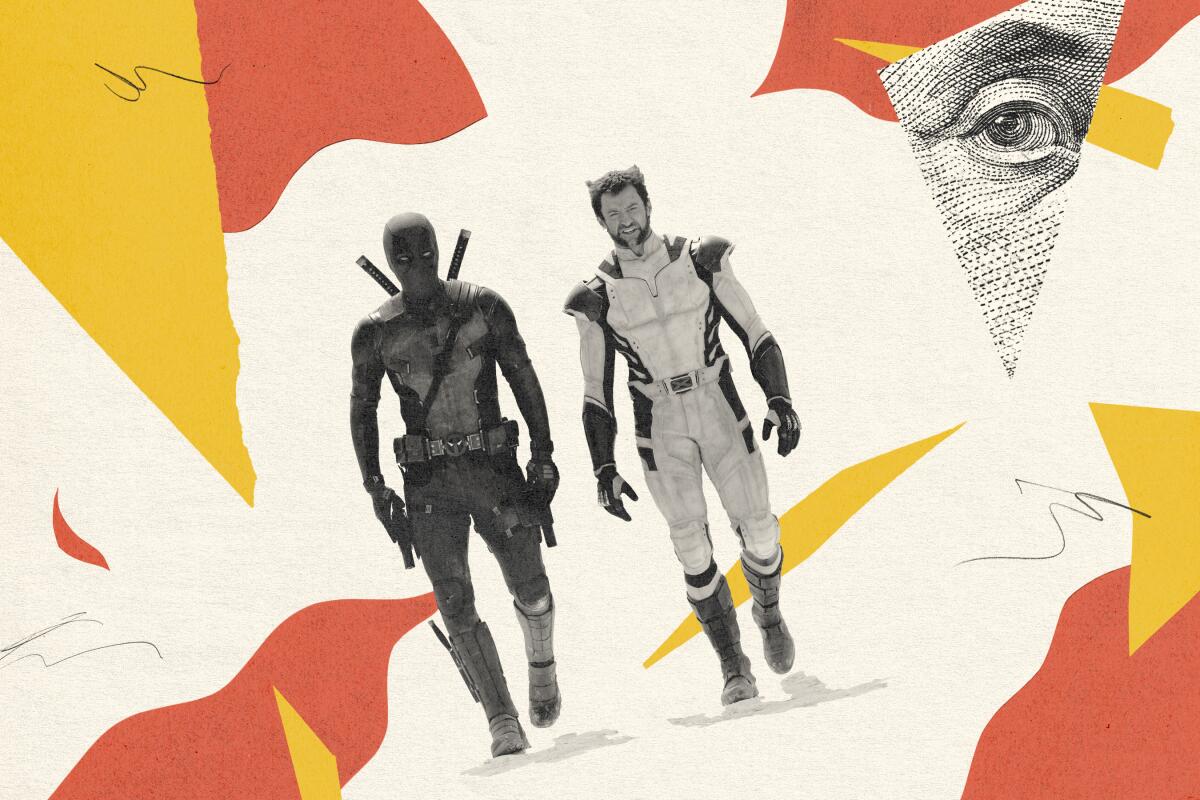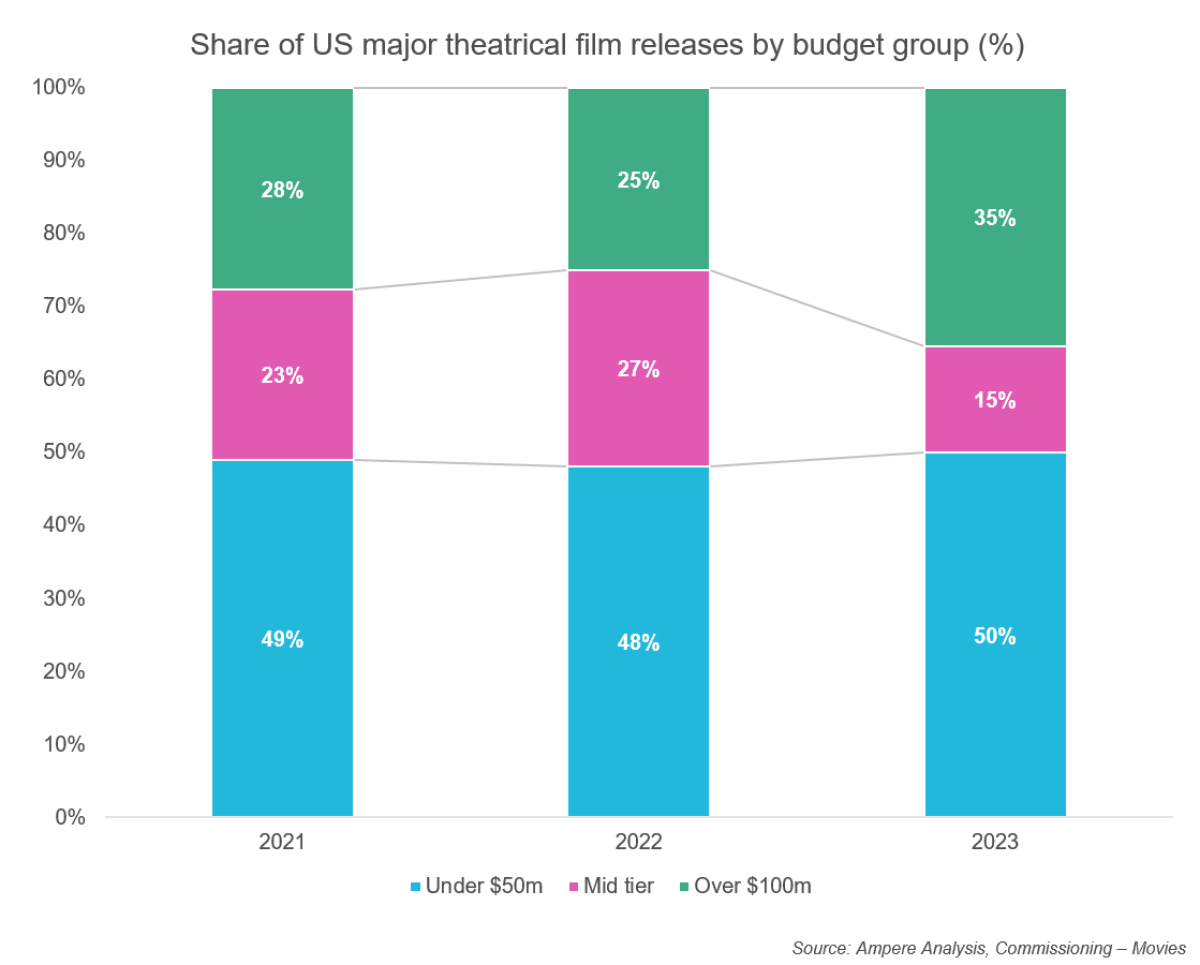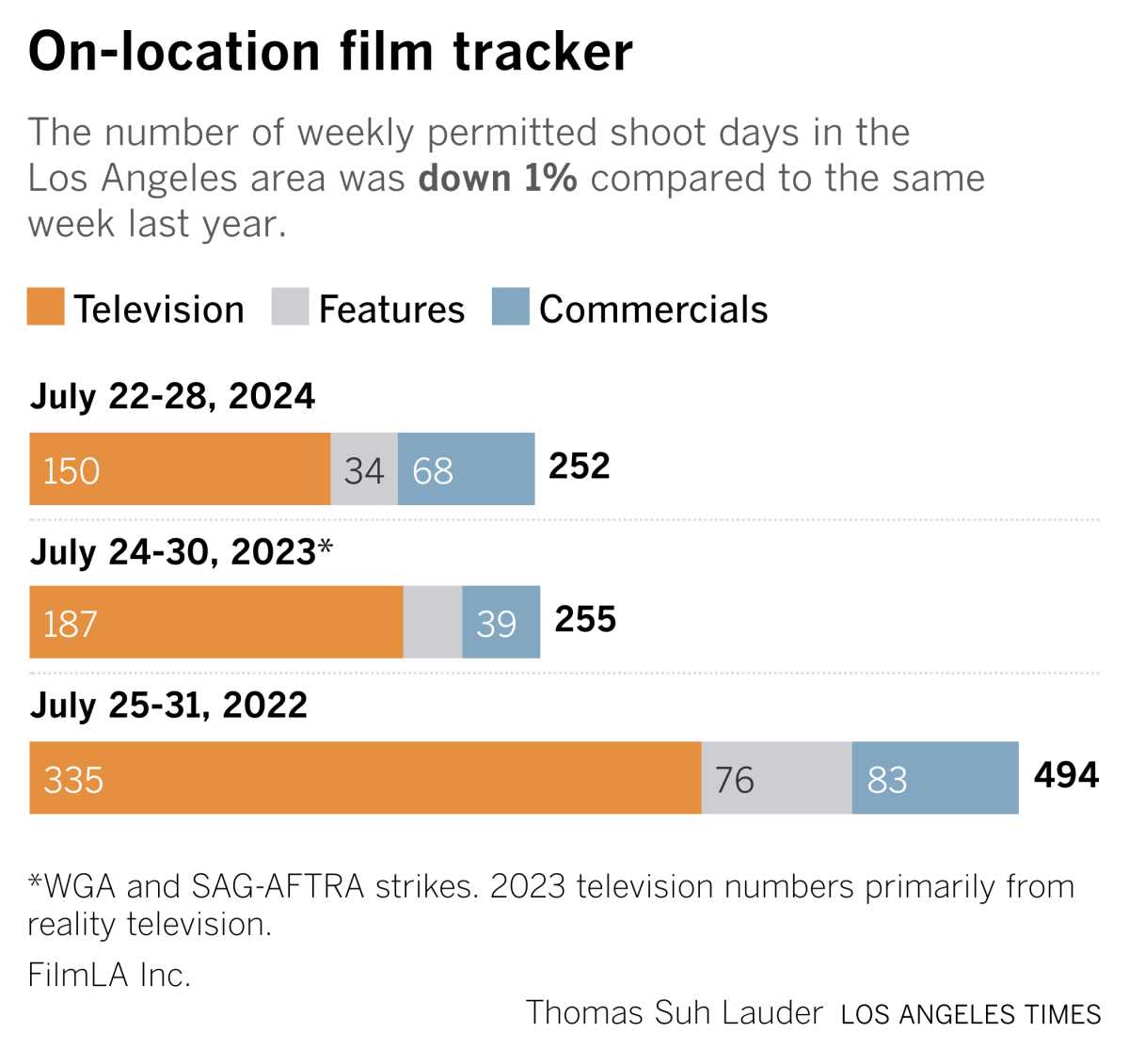Yes, Hollywood still needs superheroes and I.P. But don’t forget the mid-tier movies

- Share via
Sorry, haters, but the success of Marvel Studios’ “Deadpool & Wolverine” shows just how much the theatrical film business needs comic book movies.
Walt Disney Co.’s latest blockbuster grossed $211 million in the U.S. and Canada from Thursday through Sunday, marking the biggest debut ever for an R-rated film.
The box office is still down 17% this year compared with the same time in 2023. This decline has a lot to do with the fact that “Deadpool & Wolverine,” which cost an estimated $200 million to produce, is the only major superhero picture on the schedule this summer, with both Marvel and Warner Bros.’ DC unit in reset mode to varying degrees.
Yes, the strikes and the general malaise in Hollywood have played a role in dragging down a cinema business that’s still recovering from the pandemic. But it’s more about the types of movies being released than the sheer number of them. As of July 21, the number of wide releases for 2024 was 53, the same as at this point last year, according to Comscore. Revenue was still down by double digits.
The most glaring difference between this year and last? To misquote Edna Mode from “The Incredibles”: No capes.
Last year’s glut of low-quality superhero sequels and iffy brand extensions tested audiences’ patience.
But “franchise fatigue” is a selective phenomenon, as proved by the recent run of huge intellectual property-fueled hits, including “Inside Out 2” and “Twisters.” Moviegoers are more than happy to turn out for characters they actually enjoy. Studios need to invest in areas other than superhero movies, and they’ve had some recent success with films based on books, toy brands and video games. Still, there’s no way they can shake the spandex.
The challenge for studios is coming up with the right mix of movies in order to generate better financial returns, as their parent companies try to meet Wall Street’s demands for profits post-streaming wars.
A recent study by London-based market research firm Ampere Analysis offered some interesting insights into how studios might better configure their film slates to both drive box office results and get the most bang for their buck. After all, entertainment companies can’t control changes in consumer behavior, but they can try to better align their production slates with audience tastes.
One suggestion from Ampere is to invest more in “mid-tier” movies (those costing roughly $50 million to $100 million). This approach would enable studios to target specific audience groups and launch new franchises more effectively, the firm argued. It would, at the very least, give companies more at bats.
And yet, such films may be underutilized. According to Ampere data, only 15% of theatrical releases from the five major studios were in this budget range last year, down from 27% in 2022. Meanwhile the percentage of films that cost more than $100 million to make increased to 35% in 2023, compared with 25% during the prior year.

Now, betting on mid-range movies is easier said than done.
Since the onetime profit center known as the home video market collapsed, it’s been harder for studios to justify taking bets in that budget category. However, studios have shown that certain mid-tier titles can do well, including Sony’s animated “The Garfield Movie,” Paramount’s “Bob Marley: One Love” and A24’s “Civil War.”
Studios clearly aren’t going to pull back on blockbusters, which have been the bread and butter of the industry for as long as anyone can remember. But increasing investment in the right kinds of mid-range movies, such as crime thrillers and action-adventure films, would be a welcome development.
Beyond diversifying their lineups, the other question is whether studios can find ways of reducing their risk by lowering the costs of individual productions, which is a trickier task.
The reason a steamy sports-related psychodrama such as “Challengers” costs $55 million isn’t because production has become dramatically more expensive or due to a supply chain issue affecting tennis rackets. It’s because the A-list talent is getting paid a lot of money. It’s also why “Fly Me to the Moon,” a space race rom-com, cost Apple $100 million.
If you ask any agent, they’ll say that this expense is justified. Movies like these wouldn’t have a chance of getting made and distributed widely without a big-name star attached.
However, Ampere survey data suggest that the power of A-list actors to draw audiences may be declining. According to a recent global consumer survey by the firm, 35% of respondents said they were driven to new content because they liked the actors or celebrities who were featured. That’s down from 40% who agreed with that sentiment two years ago.
The genre of the content remains the most influential factor for consumers in the survey (47%), according to Ampere.

Some executives hope that generative artificial intelligence will help studios save millions on production costs. There’s a case to be made that experimental video tools, such as OpenAI’s Sora, will help save time and money on special effects and animation. But the utility of these programs remains unproven for longform content. As for the much hyped cost savings? We’ll see.
The technology is moving fast, and it’s understandable that studio chiefs would dream of a technological fix that would let them make a film that looks more expensive than it is, while not having to hire as many people. But it seems just as likely that AI will be better suited for helping artists with fewer resources create scenes that they otherwise wouldn’t.
So, instead of just saving some studio executives money on their blockbusters, imagine using technology to empower independent creatives to make something for $5 million that would normally cost $50 million. That sounds infinitely cooler to me.
You’re reading the Wide Shot
Ryan Faughnder delivers the latest news, analysis and insights on everything from streaming wars to production — and what it all means for the future.
You may occasionally receive promotional content from the Los Angeles Times.
Stuff we wrote
Benched by the NBA, Warner Bros. Discovery boss David Zaslav faces tough questions. “They can’t go on like this,” Bank of America analyst Jessica Reif Ehrlich said, referring to the lagging stock and string of missteps.
Can the Paris Summer Olympics give Peacock the streaming boost it needs? Peacock will have 5,000 hours of live coverage which is aimed at bringing in more subscribers to the platform. The app lost 500,000 subscribers during its most recent quarter.
Hollywood power brokers pushed for Biden to step down. Now they’re stepping up for Harris. George Clooney, Netflix co-founder Reed Hastings and other Hollywood heavyweights, who pressured President Biden to not seek reelection, have rallied behind the campaign of Vice President Kamala Harris.
Get paid or sue? How the news business is combating the threat of AI. Many news outlets are already dealing with declining revenue from digital ads and subscriptions. Now, their business models are poised to be disrupted again by AI.
ICYMI
Lots of labor activity during the past week.
Teamsters and other crew unions reach deals with studios
Video game actors are on strike. Here’s what that means
‘World of Warcraft’ game developers vote to unionize
Disneyland, employees avert strike with tentative deal
Number of the week

Well, this is probably the least surprising media lawsuit of the year.
Warner Bros. Discovery on Friday sued the NBA in New York Supreme Court over a new media rights deal that cuts the league’s longtime TV partner, Turner Sports, out of the picture.
As my colleague Stephen Battaglio reported, the suit asserts that the NBA breached the terms of its current deal by refusing to honor Turner’s right to match an offer from Amazon. Turner argues that it matched the bid, but that the NBA wanted to work with Amazon anyway.
In addition to Amazon, the deal also awarded packages to Comcast Corp.-owned NBCUniversal and Walt Disney Co.’s ESPN, a longtime TV partner of the league.
The new set of deals is set to earn the league $77 billion over 11 years, starting with the 2025-26 season. Amazon is believed to be paying about $1.8 billion a year in its deal. In plain terms, it’s good to be the NBA.
There’s little doubt that “Inside the NBA” co-host Charles Barkley is at least partly right that Turner Sports was the underdog in latter part of the negotiations. The league wants to be on a big, global streamer. Warner Bros. Discovery, of course, can say that it does have a streaming service, in the form of Max. But its reach is nowhere near that of the e-commerce giant.
If the Warner Bros. Discovery lawsuit succeeds, my bet is that it will be in the form of a settlement. Suing an organization you want to continue doing business with is never ideal. Peter Kafka at Business Insider has a thorough analysis here.
Before you feel too bad for TNT, though, remember that Warner Bros. Discovery did not renew its package during an exclusive negotiating period with the NBA, allowing the league to put it out in the open market. Oops.
Best of the web
— Good one from Josef Adalian: Inside the 1995 media merger that changed Disney forever. (Vulture)
— How Joe Rogan became a comedy kingmaker in Austin. (Bloomberg)
— Behind Jeff Bezos’ crisis at the Washington Post. (The Atlantic)
Film shoots
On-location TV production in L.A. is still down from a year ago, according to FilmLA, despite the fact that the WGA and SAG-AFTRA strikes were going on at this time last year. The decline is largely due to a steep drop in reality TV shoots. Hat tip to L.A. Times data guru Thomas Suh Lauder for the context.

Finally ...
If you haven’t been keeping up with the L.A. Times’ 1999 Project, a look back at a great year in culture, please check it out. Recent installments highlight the influence of “Eyes Wide Shut” and Chris Rock’s “Bigger & Blacker.”
Separately, I’m thinking of starting of starting my own personal 1994 Project, in honor of a fun year for punk rock and post-grunge alternative music. This newsletter was partly written to the dulcet tones of SoCal band the Offspring’s 30-year-old banger album “Smash.”
And I know I’ve written about the French heavy metal band Gojira here before, but they actually made global news last week by performing at the opening ceremony for the Paris Olympics.
The Wide Shot is going to Sundance!
We’re sending daily dispatches from Park City throughout the festival’s first weekend. Sign up here for all things Sundance, plus a regular diet of news, analysis and insights on the business of Hollywood, from streaming wars to production.
You may occasionally receive promotional content from the Los Angeles Times.




